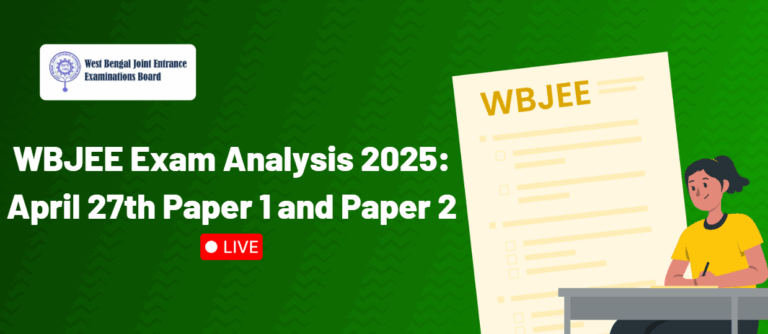
WBJEEB(West Bengal Joint Entrance Examination Board) has officially released the exam syllabus for 2025. The Syllabus is published in the information bulletin on the official website. The syllabus for WBJEE Covers both the 11th and 12th Class Syllabus. The Class 11th has 40-45% weightage in the exam. At the same time, class 12th has 55-60% weightage in the exam.
The WBJEE Exam is Scheduled to be on April 27th, 2025. The Last date to Apply for the Exam is 23rd February 2025. While Preparing for the exam knowing the syllabus is a crucial part. This article provides a comprehensive guide to the subject-wise syllabus.
Subject-wise Syllabus for 2025
| Subject | Syllabus |
| Mathematics | Click Here to Download |
| Physics | Click Here to Download |
| Chemistry | Click Here to Download |
WBJEE Syllabus for Mathematics
Mathematics is a crucial part of the WBJEE Exam. Mathematics has a 50% weightage as the paper on mathematics is conducted separately from physics and chemistry. Physics and Chemistry together hold 50% weightage. At the same time, Mathematics Holds 50% Weightage.
Here’s the Mathematics Syllabus for WBJEE 2025.
| Unit | Topic | Details |
| Algebra | A.P., G.P., H.P. | Definitions, general term, summation of first n terms (∑n, ∑n², ∑n³), Arithmetic/Geometric series, A.M., G.M. and their relation. |
| Infinite G.P. series | Sum of infinite geometric series. | |
| Logarithms | Definition & Properties | General properties, change of base. |
| Complex Numbers | Definition & properties | Complex conjugate, triangle inequality, amplitude, square root, cube roots of unity. |
| De Moivre’s Theorem | Statement only, applications in complex numbers. | |
| Polynomial Equations | nth degree equation & roots | nth degree equation has exactly n roots (statement), quadratic equations with real coefficients, nature of roots, and formation. |
| Permutation & Combination | Permutation of n things taken r at a time | Permutation with repetitions, exclusion of circular permutations. |
| Combination of n things taken r at a time | Combination of different things, basic properties, problems involving both permutations & combinations. | |
| Mathematical Induction | Statement and proof by induction | Sum of squares & cubes of first n natural numbers, divisibility properties. |
| Binomial Theorem | Positive integral index | General term, middle term, equidistant terms, properties of binomial coefficients. |
| Matrices | Concepts of m × n matrices | Addition, scalar multiplication, matrix multiplication, transpose, determinant, properties of determinants. |
| Inverse of a matrix | Minor, cofactor, adjoint, non-singular matrix, inverse. Solutions of system of linear equations (≤ 3 variables). | |
| Sets, Relations & Mappings | Sets, subsets, power set, complement | Union, intersection, difference, Venn diagrams, De Morgan’s Laws, Cartesian product of sets. |
| Relations & Mappings | Properties, equivalence relations, range, domain, injective, surjective, bijective, composition, inverse. | |
| Statistics & Probability | Measures of dispersion | Mean, variance, standard deviation, frequency distribution. |
| Probability rules | Addition & multiplication rules, conditional probability, Bayes’ Theorem, independence of events, Binomial distribution. | |
| Trigonometry | Trigonometric functions | Addition & subtraction formulas, multiple & submultiple angle formulas, general solution of trigonometric equations. |
| Properties of triangles & inverse trigonometry | Inverse trigonometric functions & properties. | |
| Coordinate Geometry (2D) | Distance & section formula | Area of a triangle, collinearity, polar coordinates, transformation between Cartesian & polar, locus problems. |
| Equation of a line & conditions | Equations of lines, angles between lines, perpendicularity & parallelism, distance of a point from a line. | |
| Conic Sections | Parabola, ellipse, hyperbola | Directrix, focus, eccentricity, classification, standard equations, parametric equations. |
| Coordinate Geometry (3D) | Direction cosines & ratios | Distance between two points, section formula, equations of straight lines & planes. |
| Calculus | Differential Calculus | Functions, limits, continuity, derivatives, chain rule, Rolle’s Theorem, L’Hospital’s Rule, second-order derivative. |
| Integral Calculus | Indefinite integrals, standard functions, integration by parts, substitution, partial fractions, definite integrals. | |
| Differential Equations | Formation of differential equations | Solution of homogeneous equations, separation of variables, linear first-order differential equations. |
| Applications of Calculus | Tangents, normals & maxima/minima | Conditions of tangency, monotonicity, differential coefficient as rate measure, area bounded by elementary curves. |
| Vectors | Operations with vectors | Addition of vectors, scalar multiplication, dot product, cross product, scalar triple product. |
WBJEE Syllabus for Physics
WBJEE conducts Physics and Chemistry in the same paper. The Physics is conducted for 50 Marks. The Candidates should Concentrate more on grasping the basic concepts and understanding the Applications of Physics. If there is more understanding of the basic concepts it is easier for the candidates to score higher score.
Here is the syllabus for Physics
| Unit | Topic | Details |
| Physical World, Measurements, Units & Dimensions | Units & Dimensions of physical quantities | Dimensional analysis & its applications, error in measurements, significant figures. |
| Dimensional analysis | Understanding and using dimensional analysis for physical quantities and equations. | |
| Kinematics | Scalars & vectors | Representation of vectors in 3D, dot & cross product & their applications. |
| Equations of motion | Equations of motion with uniform acceleration, time-velocity graphs. | |
| Laws of Motion | Newton’s laws of motion | Using algebra & calculus, inertial & non-inertial frames, conservation of linear momentum with applications, elastic & inelastic collisions. |
| Centripetal force | Banking of roads, relative velocity, projectile motion & uniform circular motion. | |
| Work, Power, Energy | Work & energy | Work-energy theorem, power, energy, work done by constant & variable forces, PE & KE, conservation of mechanical energy. |
| Conservative and non-conservative forces | PE of a spring, energy transformation and loss due to non-conservative forces. | |
| Motion of Centre of Mass, Connected Systems, Friction | Centre of mass of a two-particle system | Motion of connected systems, torque, equilibrium of rigid bodies, moments of inertia of simple geometric bodies (2D). |
| Conservation of angular momentum | Friction and laws of friction. | |
| Gravitation | Kepler’s laws | Universal law of gravitation, acceleration due to gravity (g), variation of g, gravitational potential & PE, escape velocity, orbital velocity. |
| Bulk Properties of Matter | Elasticity & Hooke’s law | Young’s modulus, bulk modulus, shear rigidity modulus, Poisson’s ratio, elastic potential energy. |
| Fluid pressure | Pressure due to a fluid column, buoyancy, Pascal’s law, effect of gravity on fluid pressure. | |
| Surface tension & Viscosity | Surface energy, capillary rise, Reynolds number, Bernoulli’s theorem, terminal velocity, Stoke’s law. | |
| Heat & Thermal Physics | Heat, temperature & ideal gas laws | Thermal expansion of solids, liquids & gases, isothermal & adiabatic processes, specific heat, Cp, Cv, calorimetry. |
| Heat transfer | Conduction, convection, radiation, Stefan’s law, Newton’s law of cooling. | |
| Thermodynamics | First & second law of thermodynamics | Reversible & irreversible processes, thermal equilibrium, heat, work & internal energy. |
| Kinetic Theory of Gases | Equation of state of a perfect gas | Assumptions in kinetic theory, pressure, temperature, rms speed, degrees of freedom, Avogadro number. |
| Oscillations & Waves | Simple harmonic motion (SHM) | Time period, frequency, restoring force, energy in SHM (KE & PE), free, forced & damped oscillations. |
| Wave motion | Equation for progressive wave, longitudinal & transverse waves, Doppler effect, standing waves, resonance, sound waves. | |
| Electrostatics | Coulomb’s law & electric field | Force between charges, electric field due to point charge, electric field lines, Gauss’ theorem, capacitors. |
| Current Electricity | Electric current, Ohm’s law & resistance | Electrical energy & power, Ohmic & non-Ohmic conductors, Kirchhoff’s laws, Wheatstone bridge, potentiometer, electric cell. |
| Magnetic Effect of Current | Magnetic field & Biot-Savart law | Force on current-carrying conductors, torque experienced by a current loop, moving coil galvanometer, conversion to ammeter & voltmeter. |
| Magnetics | Magnetic dipole moment | Earth’s magnetic field, para-, dia- & ferromagnetic substances, electromagnets, permanent magnets. |
| Electromagnetic Induction & AC | Faraday’s laws & Lenz’s Law | Induced emf & current, eddy currents, alternating currents, resonance, wattless current. |
| Electromagnetic Waves | Characteristics of EM waves | Transverse nature, electromagnetic spectrum, applications of different waves. |
| Optics I (Ray Optics) | Reflection, refraction & lenses | Spherical mirrors, thin lens formula, magnification, refraction & dispersion through a prism, optical instruments. |
| Optics II (Wave Optics) | Scattering & interference | Young’s double slit experiment, fringe width, diffraction, Raman effect, laws of reflection & refraction. |
| Modern Physics | Particle nature of light | Photoelectric effect, wave-particle dualism, de Broglie relation, atomic models, hydrogen spectrum. |
| Nuclear Physics | Isotopes, radioactivity, decay law, nuclear fission & fusion, binding energy, mass-energy relation. | |
| Solid-State Electronics | Energy bands & semiconductors | Diode characteristics, rectifiers, LED, solar cells, Zener diodes, transistors, logic gates (OR, AND, NOT, NAND, NOR). |
WBJEE Syllabus for Chemistry
The Chemistry carries 50 Marks on the WBJEE Paper. It is easier to score in chemistry compared to the other 2 subjects. So it is essential to know and concentrate more on the chemistry syllabus as well.
Here is the Chemistry Syllabus.
| Topic | Unit | Details |
| Atoms, Molecules, and Chemical Arithmetic | Atoms, Molecules, and Chemical Arithmetic | Dalton’s atomic theory, Gay Lussac’s law, Avogadro’s hypothesis, atomic mass, molecular mass, equivalent weight, valency, mole concept, chemical formulae, balanced equations, oxidation-reduction reactions, concentration units (molarity, molality, normality), empirical & molecular formulas. |
| Atomic Structure | Atomic Structure | Nuclear atom concept, Rutherford’s model, Bohr’s model, quantum numbers, electronic configurations, Aufbau Principle, Pauli’s Exclusion Principle, Hund’s Rule, dual nature of matter, de Broglie’s relationship, uncertainty principle, atomic orbitals, shapes of s, p, d orbitals. |
| Radioactivity and Nuclear Chemistry | Radioactivity and Nuclear Chemistry | α-, β-, γ-rays, artificial transmutation, radioactive decay, half-life, units of radioactivity, stability of atomic nucleus, neutron-proton ratio, radioisotopes, nuclear fission & fusion reactions. |
| Periodic Table and Chemical Families | Periodic Table and Chemical Families | Modern periodic law, periodic trends (atomic radii, valency, ionization energy, electronegativity, metallic character), representative & transition elements, noble gases, hydrogen’s position. |
| Chemical Bonding and Molecular Structure | Chemical Bonding and Molecular Structure | Octet rule, electrovalent, covalent, coordinate bonds, hybridization (sp, sp², sp³), molecular orbital theory, VSEPR concept, resonance, electronegativity, dipole moment, hydrogen bonding. |
| Coordination Compounds | Coordination Compounds | Double salts & complex salts, Werner’s theory, coordination number, IUPAC nomenclature, color, magnetic properties, shapes of coordination compounds. |
| States of Matter | Solid State | Types of solids (molecular, ionic, covalent, metallic), amorphous vs. crystalline, unit cell, density, packing efficiency, defects, electrical & magnetic properties, band theory, semiconductors. |
| Liquid State | Vapour pressure, viscosity, surface tension. | |
| Gaseous State | Boyle’s Law, Charles’ Law, kinetic theory, ideal gas equation, Dalton’s Law, Graham’s Law, van der Waals equation, real gases, liquefaction of gases. | |
| Chemical Energetics and Dynamics | Chemical Energetics and Dynamics | First law of thermodynamics, enthalpy, Hess’s law, entropy, free energy, spontaneity, chemical equilibrium, Le Chatelier’s principle, factors affecting reaction rates, collision theory, Arrhenius equation, first-order reactions. |
| Physical Chemistry of Solutions | Physical Chemistry of Solutions | Colloids (types, properties, coagulation), electrolytic solutions (conductance, Faraday’s laws), non-electrolytic solutions (Raoult’s law, colligative properties). |
| Ionic and Redox Equilibria | Ionic and Redox Equilibria | Ionization of weak electrolytes, pH scale, buffer solutions, solubility product, common ion effect, oxidation-reduction reactions, redox titrations, electrochemical series, Nernst equation. |
| Hydrogen | Hydrogen | Isotopes, hydrides, properties of water, hydrogen peroxide, hydrogen as a fuel. |
| Chemistry of Non-Metals | Chemistry of Non-Metals | Carbon (allotropes, CO, COâ‚‚), nitrogen & phosphorus compounds, oxygen & sulfur compounds, halogens & interhalogen compounds. |
| Chemistry of Metals | Chemistry of Metals | Metallurgy, extraction of Na, Ca, Al, Fe, Cu, Zn, steel manufacturing, electroplating, anodizing, galvanizing, K₂Cr₂O₇ & KMnO₄. |
| Industrial Chemistry | Industrial Chemistry | Production of H₂SO₄, NH₃, HNO₃, Na₂CO₃, polymers (natural & synthetic), biodegradable polymers. |
| Surface Chemistry | Surface Chemistry | Adsorption, catalysis, colloidal state, emulsions. |
| Environmental Chemistry | Environmental Chemistry | Pollution (air, water, soil), ozone layer, smog, greenhouse effect, global warming, green chemistry. |
| Organic Chemistry | Organic Chemistry | Hybridization of carbon, isomerism, IUPAC nomenclature, electronic effects, stability of intermediates, tautomerism, electrophiles & nucleophiles. |
| Organic Compounds | Organic Compounds | Alkanes, alkenes, alkynes, Grignard reagents, SN1 & SN2 reactions, Markovnikov’s rule, haloalkanes, alcohols, ethers, aldehydes, ketones, carboxylic acids, amines. |
| Aromatic Chemistry | Aromatic Chemistry | Benzene (structure, aromaticity, electrophilic substitution), phenols, aldehydes, ketones, diazonium salts. |
| Application-Oriented Chemistry | Application-Oriented Chemistry | Antiseptics, analgesics, antacids, vitamin C. |
| Biomolecules | Biomolecules | Carbohydrates, amino acids, ADP & ATP, nucleic acids. |
| Qualitative Analysis | Qualitative Analysis | Acid & basic radicals, organic functional group detection. |
Also Check: WBJEE VS JEE
Frequently Asked Questions
1. Did the Registrations for WBJEE Commence?
The Registrations for WBJEE commenced on 22nd January 2025 and the last date to apply for WBJEE is 23rd February 2025.
2. Does WBJEE and JEE Main have the same Syllabus?
Yes, the WBJEE covers 90-95% of the topics covered in JEE Mains.
3. How Many times is WBJEE conducted in a year?
WBJEE is conducted Once every year in pen-and-paper mode.
4. Is WBJEE Ranking Based on the Percentile?
No, the WBJEE Exam Rank is based on the number of Marks acquired by the candidates.
5. Is the Information Brochure released for WBJEE?
Yes, the Information Brochure for WBJEE has been released on the Official website.





